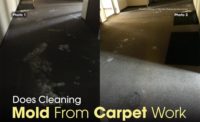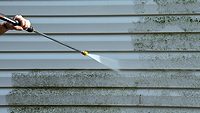
According to the U.S. Centers for Disease Control and Prevention (CDC), health care associated infections (HCAI) are currently the fourth leading cause of death in the United States, with an estimated death toll of nearly 100,000 per year. This equates to the crash of a commercial airliner every day, with over 270 deaths every 24 hours. Infections picked up in health care facilities lead to more deaths per year than breast cancer, AIDS, and automobile accidents combined. In a separate study, the CDC estimated that the costs for such infections, which are often preventable, are nearly$40 billion per year.
This is a tragic loss of life and enormous waste of scarce resources. That is why restoration contractors are increasingly being called to bring their specialized cleaning skills to the health care arena. In such situations, physical destruction of pathogens is preferred over harsher and harsher chemicals since, over time, many harmful microbes develop a resistance to antimicrobial agents. The ability to deep clean intricate items is even more important in light of several studies by the American Medical Association, which indicate that 30 to 60% of micro-organisms are left behind after standard hospital cleaning practices.

A microfiber cleaning cloth was saturated with raw sewage.
Using Ultrasonic Cleaning to Control Infections
Fortunately, there is an option that has been proven to dramatically enhance normal cleaning procedures in health care facilities: ultrasonics. Ultrasonic cleaning kills bacteria and other pathogens through physical means rather than by a chemical reaction, eliminating the need for harsh compounds. This physical destruction of the contaminants also eradicates the potential for resistant organisms to infect patients and staff.
After more than two years of testing in both the United States and the United Kingdom, the results show conclusively that digital ultrasonic cleaning equipment is capable of removing bacterial contamination from items typically used in both institutional health care and residential settings. Over the course of three carefully controlled studies it was discovered that the machines were effective in:
- Removing both gross contamination and microscopic bacterial pathogens that are found on items after they have been involved in a black water loss (sewage).
- Destroying infectious bio-burden and bacteria that pose the greatest concern to health professionals, with a strain of methicillin-resistant Staphylococcus aureus (MRSA) chosen to serve as a surrogate for such serious strains of microbial contamination.
- Supplementing normal cleaning procedures in hospitals to significantly improve infection control without being burdensome or overly expensive.
The fact that the testing progressed from cleaning in controlled environments to utilization of ultrasonic equipment in two different hospitals in England verified that the results represent a real-world application rather than just theoretical data.

A History of Effective Cleaning
Ultrasonic cleaners use sound waves produced at frequencies higher than our ears can perceive. The process involves the use of a generator, or transducer, in a water tank, which creates high-frequency sound waves. As the sound waves move through the liquid they create compression waves that “tear” the liquid apart, leaving behind many millions of microscopic voids or partial vacuum bubbles. (The technical name for this effect is cavitation.) These small bubbles expand and eventually implode when they strike an object, and this energy dislodges contaminants even from intricately shaped surfaces.
The usefulness of ultrasonic cleaning in regards to biological pathogens such as bacteria, fungus and virus has been known for some time. However, until recently, most of these efforts have been limited to small equipment like clamps, dental molds and surgical instrument pre-cleaning.
Highlights of the Three Tests
In all three controlled studies of the effectiveness of this cleaning process a common sense approach was followed. The ability of the equipment to kill microbial contaminants was measured by collecting samples from items prior to and after being cleaned. Immediate feedback was provided in all three studies by collecting samples on swabs that were analyzed by field equipment using adenosine triphosphate (ATP) technology. ATP instruments have a long history of use in food service and health care settings to determine the cleanliness of surfaces related to biological contaminants. Such instruments provide numerical results known as relative light units (RLU). In two of the studies, side-by-side surface samples were also analyzed by an independent laboratory to determine concentrations of specific types of bacteria.
The sampling data generated during the initial study revealed that:
- The system was extremely effective in removing biological contaminants from items with heavy contamination. Bio-burden and bacterial reduction of nearly 100% (99.86% and 99.98%, respectively) was achieved for items that started with more than 1 million and 259,900 colonies of bacteria, respectively.
- There was no evidence of cross-contamination even after the water in the ultrasonic tank had been used to clean items with extreme bacterial counts.

As a further challenge, both porous and non-porous items were intentionally contaminated and then cleaned in the tank. Standard cleaning times (two to four minutes depending on the object’s size, type, and material) were used so that results useful in real-world applications could be obtained. The sampling data generated during the second study showed that:
- Pernicious bacteria types, such as those resistant to antibiotics, can be effectively cleaned from surfaces using ultrasonic equipment.
- The laboratory results for Enterococcus and Escherichia coli (or E. coli) bacteria contamination showed a 100% reduction for every non-porous item tested. The system also showed impressive results cleaning a microfiber cloth, with 100% reduction of E. coli bacteria and 97.7% reduction of colony forming units of Enterococcus.
- Laboratory testing revealed that live bacteria counts in the water when the ultrasonic machine was operating stayed close to zero even after intentional contamination with gallons of raw sewage.
An Ultrasonic Answer to Controlling Infections
Both controlled testing and field demonstrations have confirmed that ultrasonic cleaning equipment is an important tool that should be utilized to improve cleaning performance in health care settings and other critical use facilities. This improved cleaning is one of the keys to reducing health care acquired infections and limiting the personal suffering and financial loss that comes from these preventable diseases.
*This story is based on research conducted for Morantz Ultrasonics Inc. using Morantz ultrasonic cleaning equipment.









